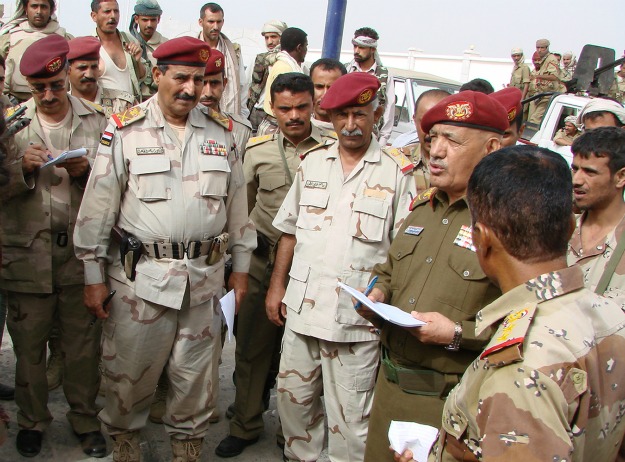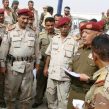
Yemen’s Military Reforms May Not Hold the Answer to Internal Stability Questions
Publication: Terrorism Monitor Volume: 11 Issue: 9
By:

Yemen’s president, Abd Rabbu Mansur Hadi, has hastened the pace of political change in Yemen with a series of decrees intended to restructure the national armed forces (Yemen Post, April 11). Not only have the April 10 decrees reshaped the Yemeni military system, but Hadi’s decisions, by favoring new players and directly targeting prominent figures of the former regime, have also profoundly altered the internal balance of power. The changes come almost one month after the official opening of the National Dialogue Conference (NDC), a centerpiece of the Yemeni transition mechanism and the forum in which Yemeni political parties will draw up a new constitution prior to the 2014 elections.
The overhaul of the armed forces represents one of the pillars on which the transition mechanism brokered by the Gulf Cooperation Council is built (Yemen Times, November 22, 2011). Military-security reforms were envisioned as a necessary measure to restore stability and to unify a fragmented army still facing a host of challenges, from the Houthi rebellion in the north to the activities of jihadis and separatists in the south. However, the armed forces’ overhaul had its own political significance, as it could not be achieved without the removal of powerful military figures still loyal to the former regime who were widely considered as a destabilizing force undermining Yemen’s political transition.
According to Presidential Decree no. 16/2013, the army will be now be composed of seven commands based on geographical districts, with military divisions based on tasks and regional army commanders independent from local military units (Barakish.net, April 11). [1] Most importantly, the Hadi decrees dismissed General Ahmad Ali Saleh, former head of the Republican Guard and eldest son of the ousted President, and General Ali Muhsin al-Ahmar, former commander of the First Armored Division (Saba News, April 12). Ali Muhsin was a long-time ally of ousted President Ali Abdullah Saleh before his defection to opposition forces during the 2011 uprising.
These measures completed the dissolution of two military units largely responsible for the army’s fragmentation and whose rivalry imposed a major obstacle to the country’s transition; the Republican Guard and the First Armored Division. Following the first major military reform process that followed the 1994 civil war, these two units began acquiring a semi-autonomous status within the regular army, gradually surfacing as two power centers in the hands of Ali Muhsin (First Armored Division) and Ahmad Ali Saleh (Republican Guard). [2] Muhsin’s division of some 40,000 soldiers was considered close to the Islamist Islah party (Aloulaye, February 5; Yemen Times, April 25). Muhsin was also the commander of the north-western military region, the site of the almost decade-long battle between the central government and Houthi rebels.
Under the authority of Ahmad Ali Saleh, the Republican Guard evolved from a small unit protecting the presidential palace to a 130,000 man elite force comprising 18 of the country’s best funded and equipped brigades, a process that changed the balance of power to the detriment of the regular army (Yemen Post, December 14, 2012). Inevitably, the growing ambitions of these two centers of power collided in the midst of the 2011 uprising, when intermittent but violent clashes between the First Armored Division and the Republican Guard erupted in Sana’a following Muhsin’s defection in March of that year.
President Hadi’s efforts to reform the military began shortly after he took charge in February, 2012. In the following two months, Hadi tried to reassign over 20 senior commanders to other positions, prompting strong resistance from those of Saleh’s allies who were affected by his measures.
In a sign of how challenging the overhaul has been Air Force Commander Muhammad Saleh al-Ahmar, the former president’s half-brother, openly defied Hadi’s order for several weeks, with his soldiers seizing and shutting down Sana’a Airport for several days before he stepped down on April 25 at the urging of the former president (Yemen Times, April 26). Similarly, Hadi began targeting Ahmad Ali directly in August 2012 by removing some of the Republican Guard’s most powerful brigades from his command. Republican Guard soldiers stormed the Defense Ministry in protest and two civilians were killed and 15 injured in the clashes that followed (Yemen Times, August 16, 2012).
The major reorganization of the armed forces dates back to the decrees issued on December 19, 2012. These pronouncements established a new structure intended to bring command and control of the army under the Ministry of Defense rather than powerful commanders (Barakish.net, December 21, 2012). Five military branches were created – Army, Air Force, Navy, Border Guards and the Strategic Reserve Force. The Special Forces, previously part of Ahmad Ali’s Republican Guard, and the counter-terrorism unit, previously part of the Central Security Forces headed by Saleh’s nephew, General Yahya Saleh, were integrated into the newly formed Special Operations Command (Yemenipress.com, December 28, 2012).
The December decrees ordered the dismantling of the First Armored Division and the Republican Guard, although the measures were not immediately brought into effect in the absence of any provisions regarding these units’ commanders, Ali Muhsin and Ahmad Ali (Yemen Times, April 15; April 25). [3] The April presidential decrees served in part to remedy this problem, as Hadi appointed Ali Muhsin the new presidential military advisor and made Ahmad Ali the new ambassador to the United Arab Emirates. Other influential members of the ex-president’s family were also shifted abroad through appointments to the Foreign Service, including Ali Abdullah Saleh’s nephew, Colonel Ammar Muhammad Abdullah Saleh (the new military attaché in Ethiopia), and Ammar Muhammad’s brother, presidential guard commander Tariq Muhammad Abdullah Saleh (Yemen’s new military attaché in Germany) (Aden Tribune, April 10).
The appointment of over 20 new commanders in the April decrees further loosened the Saleh clan’s grip on power, whereas the positions of Hadi and Ali Muhsin appear to have been strengthened. Indeed, almost half of the new appointees in the South are considered allies of President Hadi (who comes from the southern governorate of Abyan) while in the north, Ali Muhsin’s associates now control the other half of the military (FnaYemen, April 10; The National [Abu Dhabi], April 15).
Hadi’s recent decrees mark an important shift towards a more centrally organized Yemeni Army while weakening the personal patronage system that has traditionally entangled the security forces, but questions remain.
While the removal of the remnants of the Saleh network from command positions will surely diminish the influence of loyalists to the former regime within the military establishment, the balance of power has shifted dangerously towards Ali Muhsin, leaving room for future rivalries along geographic lines. Ali Muhsin’s rise suggests that the exploitation of Yemen’s tribal and patronage dynamics was not just a tactic of the former regime, but also formed a basis for compromises necessary to avoid internal backlash. Although the envisioned aim of Yemen’s military reforms was to reduce the influence of powerful commanders and to create a more unified army, the rise of Ali Mohsin’s associates in the northern districts and the appointment of Hadi’s men in the south risks the creation of further infighting as both forces seek to extend their influence in an increasingly divided country.
Notes
1. Yemen Presidential Decree 16/2013, April 10, 2013, https://presidenthadi-gov-ye.info/en/archives/presidential-decree-divides-military-fields-in-yemen-into-seven-geographical-regions-/.
2. International Crisis Group, “Yemen’s Military-Security Reform: seeds of new conflict?” April 4, 2013. Available at: https://www.crisisgroup.org/en/publication-type/media-releases/2013/mena/yemens-military-security-reform-seeds-of-a-new-conflict.aspx.
3. Yemen Presidential Decreee 104/2012, https://nationalyemen.com/2012/12/22/text-of-the-presidential-decree-to-restructure-the-army/. See also the statement of the Ministry of Defense at Barakish.net, December 19, 2012, https://barakish.net/news.aspx?cat=12&sub=11&id=41446.





